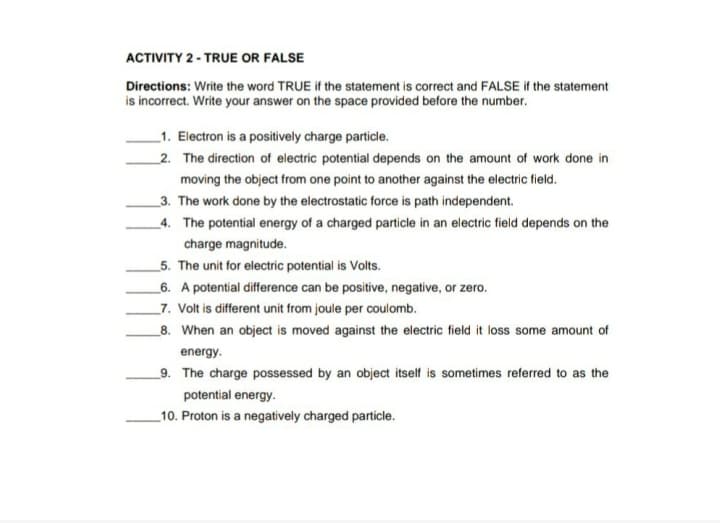_6. A potential difference can be positive, negative, or zero. _7. Volt is different unit from joule per coulomb. _8. When an object is moved against the electric field it loss some amount of energy. _9. The charge possessed by an object itself is sometimes referred to as the potential energy. _10. Proton is a negatively charged particle.
_6. A potential difference can be positive, negative, or zero. _7. Volt is different unit from joule per coulomb. _8. When an object is moved against the electric field it loss some amount of energy. _9. The charge possessed by an object itself is sometimes referred to as the potential energy. _10. Proton is a negatively charged particle.
College Physics
10th Edition
ISBN:9781285737027
Author:Raymond A. Serway, Chris Vuille
Publisher:Raymond A. Serway, Chris Vuille
Chapter16: Electrical Energy And Capacitance
Section: Chapter Questions
Problem 2CQ: An electron is released from rest in a uniform electric field. Determine whether the following...
Related questions
Concept explainers
Dielectric Constant Of Water
Water constitutes about 70% of earth. Some important distinguishing properties of water are high molar concentration, small dissociation constant and high dielectric constant.
Electrostatic Potential and Capacitance
An electrostatic force is a force caused by stationary electric charges /fields. The electrostatic force is caused by the transfer of electrons in conducting materials. Coulomb’s law determines the amount of force between two stationary, charged particles. The electric force is the force which acts between two stationary charges. It is also called Coulomb force.
Question
(a2tf) 6 7 8 9 and 10

Transcribed Image Text:ACTIVITY 2 - TRUE OR FALSE
Directions: Write the word TRUE if the statement is correct and FALSE if the statement
is incorrect. Write your answer on the space provided before the number.
_1. Electron is a positively charge particle.
_2. The direction of electric potential depends on the amount of work done in
moving the object from one point to another against the electric field.
_3. The work done by the electrostatic force is path independent.
_4. The potential energy of a charged particle in an electric field depends on the
charge magnitude.
_5. The unit for electric potential is Volts.
_6. A potential difference can be positive, negative, or zero.
_7. Volt is different unit from joule per coulomb.
_8. When an object is moved against the electric field it loss some amount of
energy.
_9. The charge possessed by an object itself is sometimes referred to as the
potential energy.
_10. Proton is a negatively charged particle.
Expert Solution
This question has been solved!
Explore an expertly crafted, step-by-step solution for a thorough understanding of key concepts.
Step by step
Solved in 2 steps with 1 images

Knowledge Booster
Learn more about
Need a deep-dive on the concept behind this application? Look no further. Learn more about this topic, physics and related others by exploring similar questions and additional content below.Recommended textbooks for you

College Physics
Physics
ISBN:
9781285737027
Author:
Raymond A. Serway, Chris Vuille
Publisher:
Cengage Learning

Physics for Scientists and Engineers, Technology …
Physics
ISBN:
9781305116399
Author:
Raymond A. Serway, John W. Jewett
Publisher:
Cengage Learning


College Physics
Physics
ISBN:
9781285737027
Author:
Raymond A. Serway, Chris Vuille
Publisher:
Cengage Learning

Physics for Scientists and Engineers, Technology …
Physics
ISBN:
9781305116399
Author:
Raymond A. Serway, John W. Jewett
Publisher:
Cengage Learning


College Physics
Physics
ISBN:
9781938168000
Author:
Paul Peter Urone, Roger Hinrichs
Publisher:
OpenStax College

College Physics
Physics
ISBN:
9781305952300
Author:
Raymond A. Serway, Chris Vuille
Publisher:
Cengage Learning

Physics for Scientists and Engineers: Foundations…
Physics
ISBN:
9781133939146
Author:
Katz, Debora M.
Publisher:
Cengage Learning